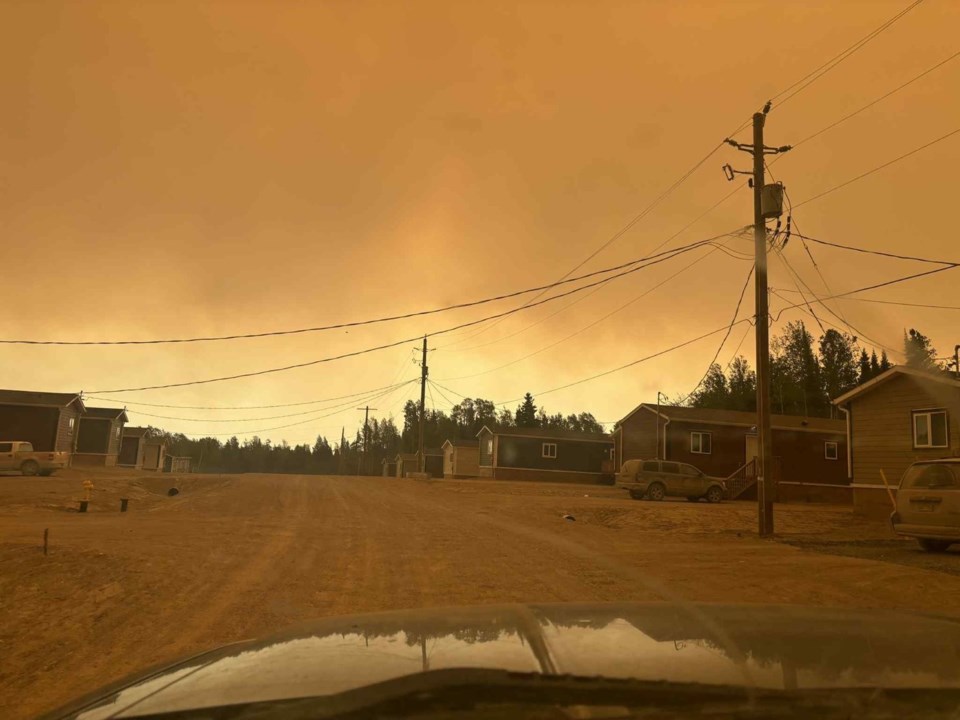When Destiny Rae boarded the military airplane that was evacuating residents of her First Nation in northwestern Ontario on Sunday, she looked out the window and saw her community in a smoky haze.
"It's very surreal, you feel very sad," Rae recalled.
"I remember looking back at the airport terminal and thinking, 'This is my home. I hope it's here when I come back."
National Defence said CC-130 Hercules airplanes have been airlifting people out of Sandy Lake First Nation as a wildfire burns through the area, and more than 1,400 people had been evacuated as of Tuesday afternoon.
Among the evacuees was Rae, who said she's not sure when she'll be able to return home — and what will be left standing — as a 1,500-square kilometre, out-of-control blaze threatens her community.
As of Monday night, the provincial government said there were more than 20 active fires in northwestern Ontario, and six of them are out of control.
One of those fires remains about 6.5 kilometres from Sandy Lake First Nation, it said.
Rae said she was in disbelief when community leaders began evacuation efforts on Saturday, and "everything just moved so fast." People began packing and planes started flying in as the smoke made it hard to breathe, she recalled.
"I walked out of the house and then to the left you see blue skies ... then I turn right and then it's just bright orange and the skies are smoky," said Rae. "It's a very scary feeling knowing then the fire is just right there."
The plane had to circle around multiple times before it could safely land in Sandy Lake, she said, because the smoke was causing poor visibility.
Rae said her mother, son, sister and sister's children boarded two military planes headed for Thunder Bay. Her brother is still in the community helping people, she added.
"It was a very sad moment when we took off," Rae said.
The province said communities in Kapuskasing and southern Ontario are hosting the evacuees.
Rae said her family landed in Thunder Bay, then another plane took the evacuees to Mississauga, Ont., just west of Toronto. About three hundred people remain there, she said, including some from Deer Lake First Nation, which was evacuated about two weeks ago.
Now, Rae said she's volunteering as a support worker as more people fly in. She's helping them sort out hotel rooms and connect with Red Cross, she said.
Across the country, tens of thousands have fled from raging wildfires in recent days, prompting both Saskatchewan and Manitoba to declare provincial states of emergency.
In Saskatchewan, the province is dealing with multiple fires in the north that have forced between 10,000 and 15,000 people to flee, including 7,000 from the La Ronge area.
Meanwhile, about 21,000 have been forced out of communities in Manitoba ahead of the fires, including all 5,000 residents of the city of Flin Flon and about 6,700 from Pimicikamak Cree Nation.
Ontario Premier Doug Ford has said firefighters from the United States have been called in to help fight the fires. On Monday, Australia's High Commission to Canada announced Australian firefighting crews have been deployed to Canada.
Although Rae is still worried about what will remain of Sandy Lake First Nation when she returns, the experience has shown her how community members have shown up for one another.
"We just have to take it one day at a time," Rae said. "Most importantly, we just help each other in a time like this ... I know we can get by if we're just there for each other."
This report by The Canadian Press was first published June 10, 2025.
Rianna Lim, The Canadian Press



